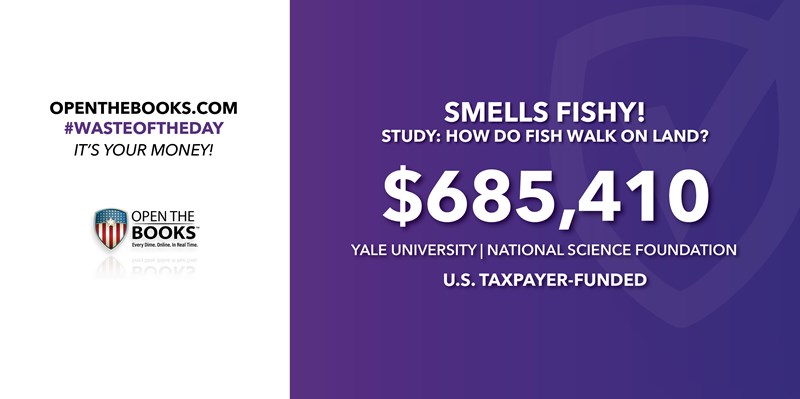
Feds Fund Princeton Art Collection Catalogue | June 14, 2021

Princeton University has a hefty $25.6 billion endowment, but the Tigers still received $748.8 million in grants since 2017.
The Ivy League university also received $399,293 from the Institute of Museum and Library Services in 2017 to catalogue its art collection.
“The Princeton University Art Museum will standardize and enhance cataloging for the 6,516 works in its drawings collection in order to increase public access for teaching, learning, research and publication, both online and onsite,” the grant summary states.
Using “image annotation tools” and “an online publishing template” among other things, the project seeks to encourage exploration and scholarly exchange on its website.
The money will be used to catalog the artwork, giving detailed descriptions, keyword tags, exhibition history and more.
“These improvements will ensure expanded public and scholarly use of the collections by university faculty and K-12 teachers, their students, community members, and international scholars,” the summary states.
With a $25.6 billion endowment, the prestigious and wealthy university should be able to pay to catalog its own artwork.
Pennsylvania Public Schools Received More Covid Aid Than Healthcare Providers | June 15, 2021

While the country fought a deadly pandemic for more than a year and schools remained closed, the education system in Pennsylvania received more federal aid than health care systems did.
The Keystone State collected more than $34 billion in federal aid, including through the CARES Act and the American Rescue Plan Act, according to the think tank Commonwealth Foundation.
But the bulk of that money did not go to the Department of Health, Medicaid programs, assisted living and nursing homes, vaccine distribution, hospitals, and other healthcare providers.
Public education received 29% ($10.1 billion) of the aid, while 24% ($8.2 billion) went to healthcare.
The Pennsylvania-based think tank found that while nursing homes received $944 million in grants from the Covid-19 aid bills, the Philadelphia School District alone got $1.8 billion.
Students were learning remotely — from home — or in a hybrid of school/home learning for most, if not all, the school year. Why did schools get $10.1 billion in federal aid on top of their annual state and federal aid?
The health system in Pennsylvania and the rest of the country struggled, and in some cases, failed, to provide adequate care during the pandemic. They should get the bulk of the Covid-19 funding, not special interests, which shuttered schools and stunted students’ growth.
Federal Study: Are Non-Heterosexual Women Drinking Too Much? | June 16, 2021

Non-heterosexual women may be drinking too much and the National Institute of Health wants to stop that.
The NIH gave $210,776 to Loyola Marymount University to study such female Facebook users in Los Angeles through an “inviting, Facebook-connected, social game.”
The study, titled, “A Novel, Gamified, Facebook-Integrated Personalized Normative Feedback Intervention to Reduce Alcohol Use and Negative Consequences among Sexual Minority Women” seeks to find ways to prevent heavy drinking among this group.
“Sexual minority women in the United States are more likely to drink alcohol, engage in heavy drinking, and experience alcohol-related problems than are heterosexual women,” the NIH grant summary says. “Yet, to date, no evidence-based intervention or prevention efforts have been developed to reduce alcohol consumption in female sexual minority community settings.”
This study set out to “narrow the disparity in alcohol intervention research” by considering an innovative intervention to lower drinking in the sexual minority women community who use Facebook, looking at their peers’ general alcohol use and whether they’re drinking to cope with sexual minority stigma.
Using Facebook, itself an alternate reality, to host a game to study people’s real-life behavior sounds less like a scientific study and more like a waste of $210,776.
The Hydrodynamics of Defecation – A Study of Beasts Pooping | June 17, 2021

Throwback Thursday!
This half-million dollar federal grant – funded by the U.S. taxpayer – stinks.
Did you know that an African elephant can poop up to 16.3 pounds per day? If that is more than you ever wanted to know about feces, you will not appreciate the rest of the findings of an April 2017 study.
The study published in the scientific journal The Royal Society of Chemistry was titled “Hydrodynamics of Defecation” and measured the size, shape and other measurements of feces from various mammals.
It was funded with $1,490 from Georgia Tech President’s Undergraduate Research Awards, and the theory explored in the defecation research came about during other research done thanks to a $556,584 grant from the National Science Foundation. That NSF grant was cited in the study as a principal funding source of the research.
A red panda poops more than one-third of a pound every day, a lion defecates just under 1 pound daily, and a sun bear relieves itself of more than 1 pound of feces per day.
Why do we care?
The group of researchers at Georgia Institute of Technology and University of Alabama at Birmingham, which documented the bowel movements of the beasts and included four videos of the animals’ private moments, thought it was important to “understand the physics by which feces are discharged.”
The researchers investigated the dimensions of large intestines and feces and, among other things, “a mathematical model of defecation.”
They compared the diameter of feces to that of the rectum and went into detail that we will not repeat here about how feces “slide” through the large intestine to their exit.
They say this information is useful in helping clinicians use non-invasive procedures to diagnose ailments of animals’ digestive system.
NOTE: David Hu, one of the researchers from Georgia Tech, earned $139,992 in 2017 -- a six-figure income.
The NSF grant funded several studies, including the paper "Duration of Urination Does Not Change With Body Size," that two of the researchers on the defecation study worked on.
Smells Fishy! How Fish Move On Land
| June 18, 2021

Claiming the second highest endowment of all higher education institutions behind Harvard University, Yale University’s $30.3 billion endowment only goes so far and clearly taxpayer money is needed to fund its research.
That’s why the prestigious Ivy League university has received $2.5 billion in grants since 2017, including $685,410 from the National Science Foundation in 2021 for studying how fish move on land, looking at the “biomechanics of amphibious fish fins and mechanical principles of stiff lightweight structures.”
Researchers found fish apply great force to their thin, lightweight fins to move on land. “Through biological experiments, engineering device design, and mathematical modeling, the project seeks to uncover relationships between the form and function of fins used to move on land,” the project states.
They said the study is useful because “the mechanics of walking fish will help address the substantial challenges in designing agile robots capable of traversing diverse environments.”
Fish’s movements on land will help guide robots for search and rescue operations go where it is impossible or unsafe for humans to go, the researchers said.
Learning about these fish is also “critical for understanding how terrestrial vertebrates evolved from an aquatic ancestor that used its fins to move on land around 400 million years ago,” they said.
The #WasteOfTheDay is presented by the forensic auditors at OpenTheBooks.com.